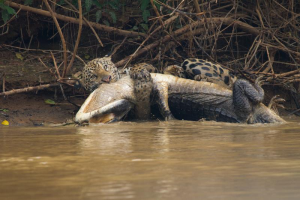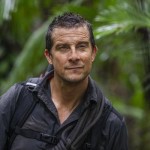It’s clear by the title alone that it is not your grandparents’ nature show. National Geographic Channel’s “Hostile Planet” takes a unique point of view – one from the perspective of the animals it chronicles, from a stealthy snow leopard to a massive orca, tiny turtles and an Arctic wolf, to get viewers hooked on their plights.
And when the stars of the show are not human and you can’t rely on a script, you never know what might happen – or when.
The series encompasses the wildest and most unspoiled parts of the earth to the most populated, from the oceans to the desert to the Arctic Circle, exploring how a changing climate is impacting animals’ habitats and how they must adapt in order to survive. It’s narrated and hosted by British adventurer and survivalist Bear Grylls, well-known for other adventure and nature shows including “Running Wild.”
Here are the staggering stats: 1,300 days of filming– yes, that’s 3 ½ years—resulting in 1,800 hours of footage shot on seven continents and in the depths of the oceans.
Currently in the midst of its six-episode run, tonight’s Earth Day edition explores the jungle, our planet’s most inhabited, diverse habitat for animals.
The old adage of survival of the fittest is never more apparent than amongst the jungle’s fiercest species, including jaguars and orangutans, who are also combating the effects of deforestation and increasingly unpredictable weather patterns in their crowded and competitive world.
In addition to the jungle, each of the other episodes zooms in on unique environments including mountains, oceans, grasslands, deserts and polar climates to examine how wildlife persists in often brutal and challenging conditions that make survival difficult.
Several of “Hostile Planet’s” filmmakers spoke last week after a screening event at Hollywood’s Neuehouse, with the venue filled to capacity largely by Television Academy members.
“We saw a need to do a series on how species have survived,” said executive producer Guillermo Navarro, who is also an Academy Award-winning cinematographer for his work on 2006’s “Pan’s Labyrinth” with another Oscar winner, director and writer Guillermo del Toro. “Things have changed more quickly in the last 50 years than they did in the hundred years before that, so it was important to address this now. It’s a new game and there are new rules for surviving and for handling adversity. It’s our responsibility to protect the planet.”
There had been strong audience reaction during the screening of the “Oceans” episode to scenes of baby turtles being plucked out of the sand by predators.
“It’s important to realize survival isn’t easy. For the baby turtles, we want people to understand their plight on emotional terms and then to examine how do we fix this,” said Sophie Morgan, one of the series’ directors and producers.
The crowd was also wowed by the photography of the ocean animals, especially the orca/killer whales, who weigh between 3,000 and 12,000 pounds and are generally described as being about as big as a school bus.
“It’s an immersive experience with new equipment,” said David Reichert, who was the director of photography on the episode, as well as on “Polar.” He explained how they used drones with long lenses, sliders, scooters and jibs to move around with the animals in ocean waters.
The photography unit’s work was lauded by director Morgan.
“They become aqua men and women in the sense that they have a sixth sense of what the animals are going to do,” said Morgan. She also explained how sometimes safety comes second, as in a situation in Norway where crews had a hard time getting close to the orca and humpback whales.
And just as in fictional dramas, the musical score plays an important role in “Hostile Planet.”
“You realize how cinematic every shot is and to see the action from many perspectives, it makes it feel like a thriller that has some sort of emotional narrative. It’s a chance to turn nature into something dramatic,” said composer Benjamin Wallfisch. “Guillermo brings dramatic know-how and good music goes along with it. The sequences are built and there’s connectivity and you are part of that. The score is as fundamental as the visuals,” he said, yet noted that although you can shoot from far away you can’t record sound from a distance.
“Our goal is to make people feel like they’re there with the animals,” said Morgan.
“It was like a military experience after we finally found a snow leopard after waiting three weeks. It’s a very committed dynamic for the crew and involves a lot of risk. Bad things can happen to us,” said Navarro.
“The greatest asset you can have is stubbornness,” said Reichert. “So many things can go wrong but the bar has been raised since ‘Blue Planet’ and now we have a much more developed story to tell.”
“You don’t know what you’re going to get like you do with actors,” the DP continued. “It can be four weeks of doing nothing. It’s a miracle when this happens. It’s an amazing event.”
Asked about intervening in any way, like feeding the animals, Reichert insisted the crew members have to be invisible. “You’re there to tell a story,” he said.
Asked if the series was a call to action, the filmmakers talked about wanting to create a sense of awareness and having people learn about solutions.
“Visual language is of our time and a way to address younger audiences. There’s a sense that comes as if animal behavior was on a different planet, but it is one planet,” Navarro said.
“They are surviving and showing us we have to do our part. We have to share a message of hope,” Morgan said. “If you give nature a chance to rebound, it can.”
(“Hostile Planet” airs Monday nights on National Geographic Channel at 9 p.m. ET/PT, 8 p.m. Central.)



